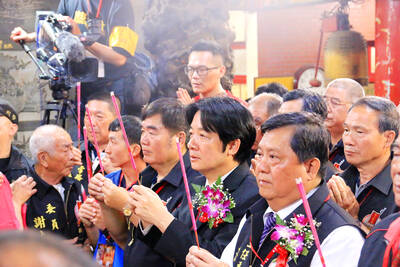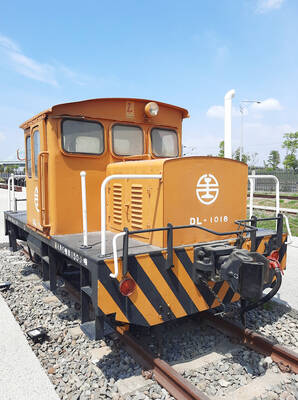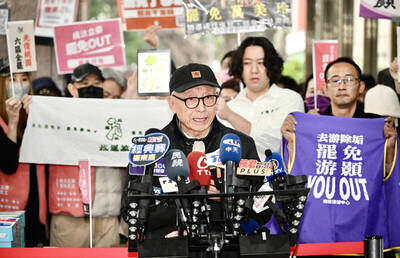The circus rolled into town last Thursday — the plastic circus, that is.
Despite the global economic crisis, the Taipei Toy Festival is still going strong.
Since 2004 the annual event, which ran from July 9 to July 12 this year and is the largest convention in Asia dedicated exclusively to art toys, has brought together an international coterie of toy makers and distributors. More than 200 designers made an appearance at Huashan Culture Park, where this year’s edition was held, more than double the approximately 80 designers who attended in 2008.
For the grand opening at 10:30am last Thursday, a long line of fans snaked from Huashan’s east entrance down Jinshan North Road (金山北路) around the corner to Zhongxiao East Road (忠孝東路). Wang Shu-ching (王淑卿), who was waiting near the back of the line with a friend, said she arrived early in the hope of getting her hands on a limited-edition C.i.Boy figure, one of four toys given out to the first 500 fans to arrive on each day of the festival.
“I consider these toys works of art,” said Wang, who counts Husky x 3, Jason Siu and Toys2R among her favorite brands and designers. Wang added that she has invested about NT$20,000 to NT$30,000 in her collection of nearly 30 figures since attending the first Taipei Toy Festival six years ago.
“Designer toys weren’t really well known in Taiwan back then and I went because I was curious to see what it was all about,” said Wang.
Since then designer toys have become increasingly popular in this country, thanks in part to their use as marketing tools by retailers. Designer Demos Chiang (蔣友柏), a grandson of Chiang Kai-shek (蔣介石), and popular toy designers Devilrobots of Japan and Hong Kong-based C.i.World, creator of C.i.Boy, have all made limited-edition series for convenience stores.
The birth of the designer toy trend is commonly attributed to Michael Lau, a Hong Kong artist who in the late 1990s began making limited-edition vinyl figures based on a comic he had created. The trend quickly spread through Asia and then on to the rest of the world. The terms designer toy, art toy and urban vinyl are often used interchangeably because many of the figures are created by artists or graphic designers, influenced by street art and style, and made from high-quality plastic or vinyl in limited runs.
Jen Huang (黃仁壽), founder of toy distributor Monster Taipei (台北怪獸), launched the Taipei Toy Festival as a networking event for designers in Taiwan. The festival’s scope has since expanded, and this year’s roster of exhibitors hailed from the US, Canada, Japan, Hong Kong, the Netherlands, Italy, England and Australia.
The theme of this year’s festival was “the secret forest.”
“When designers gather, it is like a forest of creativity,” said Huang. “The festival has gotten bigger and bigger. It lets people know that creativity can make everyday life more enjoyable, even when the economy is not so great.”
The move to Huashan from Core Pacific City Living Mall (京華城), where the event was held in previous years, allowed for bigger booths that many designers set up like mini-galleries. Toy distributor Medicom’s glass cases were filled with limited-edition and one-off items for enthusiasts to cast covetous gazes upon, while Carousel Toy Shop set up a large Chinese checkers board manned with figures by Taiwanese designer D-La (陳岳樟). There were more crossover products for sale this year, including flash drives from US-based Mimoco and sneakers, bags and T-shirts by like Taiwanese line The Black Skull Union (黑面聯盟) and Hong Kong-based design house Apple Kingdom.
Designer 221trees (兩兩一樹, her real name), who won the festival’s annual Character Design Award of Taiwan (台灣原創角色藝術大賞頒獎) in 2006 after graduating from university, hopes her punk rock-influenced figures will catch the attention of other artists.
“There are designers from all around the world here and we can see what each has to offer and exchange ideas, as well as promote ourselves and potentially collaborate on projects,” she said. 221trees added that Simone Legno, the man behind the Tokidoki brand, a favorite among fashionistas and toy collectors alike, was one of the people she’d most like to meet.
Legno himself was on hand on the opening day for autographs, carefully sketching on fans’ posters. This year was the second time the Italian artist attended the Taipei Toy Festival. He says the event gives him a chance to meet designers and fans in Asia, where his designs are especially popular.
“The biggest comic convention is in San Diego but a lot of artists from Asia can’t come,” says Legno, referring to the annual Comic-Con International in California. “It’s always good to show my work and meet fans from this territory, especially in Taiwan, where I have a good following.”
Huang says the global recession hasn’t dented designers’ creativity — or fans’ willingness to drop money on their favorite figures.
“People might not be able to afford stuff like new cars or expensive brand-name items, but they are still willing to spend money on little things that bring them pleasure, and a lot of these toys only cost NT$500 to NT$1,000,” said Huang.
Many collectors were happy to go on a shopping frenzy at the festival, as evidenced by the number of attendees squeezing through the aisles with giant shopping bags in tow. But 221trees says that collecting designer toys is more than just consumerism.
“I think a lot of people see their lives as dull and boring, so they have the urge to seek out things that are meaningful to them. As designers, we make figures that represent different points of view or characters. When people see them, sometimes they think, ‘There is someone in the world that thinks like me.’ That’s the attraction for me, too,” she said.
New Faces
The following are few of the designers who made their Taipei Toy Festival debut this year.
John Dog (Hong Kong)
Hong Kong designer Johnson Chiang (江志強) hopes his creations will inspire people to look at life from a new perspective. His character, John Dog, is an advertising designer who travels through time from 1929 Shanghai to 1984 (which is when Chiang himself started working as a graphic designer). As part of a series of handmade items he showcased at the festival, Chiang painted vintage cameras from the 1920s with John Dog’s visage and placed them alongside hand-sculpted toys and small plaques featuring the character.
“Lenses were very basic back then and couldn’t focus well, so you had to guess what your photo would look like,” says Chiang. “John Dog wants people to realize that maybe they always want everything to be certain, but that guessing can be quite an interesting thing.”
On the Net: www.1929johndog.com
221trees (Taiwan)
221trees’ Monsters of Rock series is inspired by punk style with a few surreal twists. Her figures, which are larger and much more detailed than most urban vinyl, appeal to serious collectors who are looking for pieces closer to traditional sculpture, she says. “The collectors who are attracted to my figures have a higher income and they also tend to be already familiar with the designer toy scene, so they are seeking something cool and unusual. Our designs are cute, but also a little weird,” says 221trees.
On the Net: www.221trees.com
Tenon’Art (Taiwan)
Taiwanese designer Calvin Lin’s (林家慶) sculptures of
animals are painstakingly crafted from cardboard pieces, which buyers assemble themselves. “I’ve invested one year in designing my collection and now I want to promote it. At the festival, I can see at once what the reaction is from other designers,” says Lin of his figures, which are inspired by Nordic design and based on fairy tales like the Bremen Town Musicians. Lin’s work is a departure from the plastic toys that dominate the Taipei Toy Festival, but “they are like puzzles that turn into figures, so I thought this would be a good place to bring them.”
On the Net: www.tenonart.com.tw
Ixtee (Hong Kong)
Designers Matthew Tam (譚立德) and Pearl Ling (凌昕彤) already enjoy a following among collectors of Blythe dolls, selling clothing and other accessories to fans in Asia, Europe and the US through their eBay store. The couple recently launched their own line of ball-jointed resin dolls and hope the Taipei Toy Festival will give their new creations wider exposure. “We have a store in Hong Kong already, but Hong Kong’s network is relatively small and we want to meet people from other countries,” says Tam. He says the economy hasn’t affected collectors’ appetites for the doll clothing and hand-molded plastic accoutrements he and his wife create. “It hasn’t had a big impact. Our stuff always has supporters and we have a unique style, so if they want certain things, they come to us.”
On the Net: www.ixtee.com

The Democratic Progressive Party (DPP), Chinese Nationalist Party (KMT), and the country’s other political groups dare not offend religious groups, says Chen Lih-ming (陳立民), founder of the Taiwan Anti-Religion Alliance (台灣反宗教者聯盟). “It’s the same in other democracies, of course, but because political struggles in Taiwan are extraordinarily fierce, you’ll see candidates visiting several temples each day ahead of elections. That adds impetus to religion here,” says the retired college lecturer. In Japan’s most recent election, the Liberal Democratic Party lost many votes because of its ties to the Unification Church (“the Moonies”). Chen contrasts the progress made by anti-religion movements in

Taiwan doesn’t have a lot of railways, but its network has plenty of history. The government-owned entity that last year became the Taiwan Railway Corp (TRC) has been operating trains since 1891. During the 1895-1945 period of Japanese rule, the colonial government made huge investments in rail infrastructure. The northern port city of Keelung was connected to Kaohsiung in the south. New lines appeared in Pingtung, Yilan and the Hualien-Taitung region. Railway enthusiasts exploring Taiwan will find plenty to amuse themselves. Taipei will soon gain its second rail-themed museum. Elsewhere there’s a number of endearing branch lines and rolling-stock collections, some

Last week the State Department made several small changes to its Web information on Taiwan. First, it removed a statement saying that the US “does not support Taiwan independence.” The current statement now reads: “We oppose any unilateral changes to the status quo from either side. We expect cross-strait differences to be resolved by peaceful means, free from coercion, in a manner acceptable to the people on both sides of the Strait.” In 2022 the administration of Joe Biden also removed that verbiage, but after a month of pressure from the People’s Republic of China (PRC), reinstated it. The American

This was not supposed to be an election year. The local media is billing it as the “2025 great recall era” (2025大罷免時代) or the “2025 great recall wave” (2025大罷免潮), with many now just shortening it to “great recall.” As of this writing the number of campaigns that have submitted the requisite one percent of eligible voters signatures in legislative districts is 51 — 35 targeting Chinese Nationalist Party (KMT) caucus lawmakers and 16 targeting Democratic Progressive Party (DPP) lawmakers. The pan-green side has more as they started earlier. Many recall campaigns are billing themselves as “Winter Bluebirds” after the “Bluebird Action”